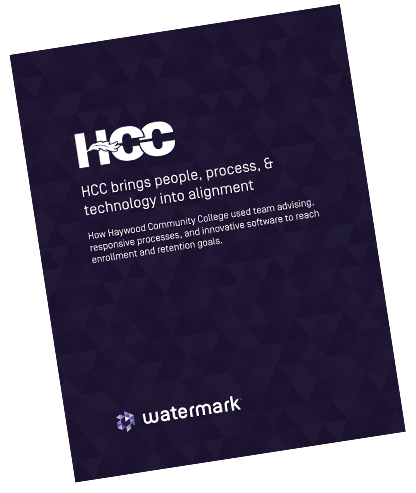

“It’s almost like you didn’t know what you were getting until you got it. I think that’s one of the great things about our usage of Watermark Student Success & Engagement over the past five years — realizing the potential it has and how we can use it to solve problems that we didn’t even know existed.”
Michael Coleman, D.B.A.
CIO, Vice President of Student Services & Technology Haywood Community College
Haywood Community College (HCC), nestled in the picturesque mountains of western North Carolina, has become a pillar of Haywood County since its establishment in 1965. The institution offers programs in various career fields like automotive and manufacturing; health sciences; natural resources and professional crafts; business administration, finance, and marketing; and much more. HCC has long been known for its visual splendor, even being renowned as one of the most beautiful campuses in North Carolina. The campus was actually founded as a designated arboretum upon its inception. On any given day a student could find themselves reading between classes in the Rhododendron Garden, relaxing by one of the campus’s arboretums, stretching their legs along Dahlia Ridge’s approximately four-mile trail system, or taking in the sunset over Mill Pond.The community college’s external beauty is reflected on the inside as well. With a dedicated staff and eager students, it is hard to have a bad day at HCC. However, just like any institution of higher education, HCC has needed to continually evolve to keep up with its changing community and culture, and change rarely comes easy.
| In the fall of 2017, HCC was preparing for their 10-year reaffirmation with the Southern Association of Colleges and Schools Commission on Colleges (SACSCOC). As a requirement of reaffirmation, a college must develop a plan — called a quality enhancement plan (QEP) — to identify key issues and focus on solutions that support student learning. Haywood’s leadership team, along with other campus stakeholders including faculty, staff, and students, identified advising as their key issue. |  |
According to Michael Coleman, D.B.A., Vice President of Student Services/CIO at HCC, the existing advising model was heavily dependent on a student’s ability to seek out support. First, the student would select their desired program of study on an admissions application without any previous consultation with an advisor or admission staff. Once admitted, the student would receive a welcome letter that had the name and contact information of their faculty advisor at the bottom. “It might as well have said, ‘May the odds be ever in your favor,’” Dr. Coleman recalls. The age-old process assumed the student knew what program they wanted to enroll in and could write their own success story by navigating their way to support unguided. “It was up to the student to contact their advisor — and if the advisor was a nine-month employee and the student was starting in the summer, the student was not likely to be able to reach them before it was too late. That’s not the way you want your operations to run.”
“We knew that for our proposed solutions to work, we would need to overcome any skepticism and prove that everyone could trust the solutions our QEP team was proposing.”
Because HCC had a limited number of faculty members that worked through the summer months, information would get lost during the transition into and out of the summer session.
 |
Students were caught in the crossfire of miscommunication and were left feeling confused and unsupported. If a student did successfully contact their advisor, there wasn’t a convenient way for the two of them to share information and communicate outside of email. These factors made the student experience less than ideal.“We knew that for our proposed solutions to work, we would need to overcome any skepticism and prove that everyone could trust the solutions our QEP team was proposing.”Because HCC had a limited number of faculty members that worked through the summer months, information would get lost during the transition into and out of the summer session. |
The existing advising process was not perfect for faculty either. They had a limited ability to track student performance because of inadequacies in their main advising software, and many departments were not aligned on best practices. This created an inability to adapt to HCC’s changing set of needs. “Any advising platform that was being used was not user-friendly. Information could not easily be shared between faculty members and support staff, causing discrepancies in what was being shared,” says Dr. Coleman.The goal of Haywood’s QEP steering committee was to create a better system of advising to improve student outcomes and achieve the college’s mission. But as a smaller school with limited resources, college leaders knew this couldn’t be achieved through manpower alone. HCC needed to replace their existing tool with a robust, agile student success software to amplify the quality work the team was already doing and fill in the missing pieces of the puzzle.
To support HCC’s goals for an improved student advising process, decision-makers chose Watermark Student Success & Engagement (SS&E). “The price was doable for our small institution, and the customer service was incomparable,” Dr. Coleman says. Plus, the ease of use, customization, and product features like internal note-taking all worked together to create the best solution for their team.
“Watermark really helped us to designate responsibilities and internal sharing,”
says Dr. Coleman.
As part of the plan, HCC also introduced success coaches who used Watermark tools such as notes, alerts, tags, filters, reports, and predictive analytics to help proactively advise students. With this technology-enabled success coaching, staff could intervene before bumps in the road became roadblocks. Behaviors like missing class for several days, being out sick, or falling behind in a course are all examples of alerts success coaches can manage to keep track of student performance. “Aligning people, process, and technology to achieve excellence in advising was critical for our QEP,” says Dr. Coleman. Through Watermark, the college hoped to streamline the advising process, improve student performance, and create a better experience on campus. As with any new initiative, creating buy-in would be a crucial, but complicated, step.
| Haywood Community College leaders knew they would face challenges when introducing new processes and technology on campus. “As we learned from other colleges, many staff and faculty members can be resistant to change, perceiving the implementation of new software to be a passing trend or an additional burden,” says Dr. Coleman. “We knew that for our proposed solutions to work, we would need to overcome any skepticism and prove that everyone could trust the solutions our QEP team was proposing.” |  |
HCC emphasized the potential for significant improvements and urged the campus to trust how much Watermark’s tools could improve their daily workflows. To quantify the benefits from a financial perspective, leaders noted that by preventing just seven students from dropping out annually, the investment in the software would be recovered. This tangible example resonated with many managers, highlighting the potential return on investment and the positive impact Watermark could have on student outcomes. Over time, the campus embraced the advantages of a more streamlined system and the necessity of the platform for the institution’s accreditation and success.
Among the greatest successes HCC enjoyed from its implementation of Watermark was more sophisticated and comprehensive advising through a team approach. On the admissions application, students now select a “career cluster,” an area of interest instead of a program, that matches with their desired area of study. They are then assigned a success team, which consists of a dedicated success coach for program degree selection and onboarding, and a faculty advisor for course selection and academic direction.
The success coach begins the relationship by reaching out to the student through SS&E to discuss the college’s degree and program options that fit with their end goals. Once a program pathway is selected, the success coach uses SS&E’s unique tagging system to notify the faculty advisor that the student is ready for academic advisement. The coach remains connected to the student for support services, and for early intervention conducted through Watermark’s alert system. The faculty advisors have custom-built filters for each of their programs that dynamically keep track of their active advisees. The innovative feature allows the advisor to run reports and interact directly with their advisees who have not yet registered for classes, students who need further outreach, and students who need more personalized communication.
The technology component has enabled the college to coordinate their processes and staff like never before. Additionally, the team advising capability enabled by Watermark has opened the door for building relationships.
HCC faculty and staff have learned that a student having a relationship with success coaches and faculty advisors simultaneously has a tremendous impact on their success. Both have unique roles to play in the student life cycle and experience, and through the team approach they can know and trust what each individual is doing in real time. Using the Watermark notes feature has allowed for a level of continuity in advising that would have been otherwise impossible to achieve. “Watermark really helped us to designate responsibilities and internal sharing,” says Dr. Coleman. “The faculty advisor can pull up and see the notes on the student account that the success coach took and instantly be able to tell what has been told to the student, what their plan is going to be academically — all those good things. It’s just right there in the system.”
The pandemic brought new challenges for HCC, including the need to track students who were impacted by COVID-19 and missing coursework. HCC leadership was able to use Watermark’s custom tagging to monitor the departure, reentrance, and long-term success of students who experienced quarantine-related absences. “We were able to track student’s long-term success, enrollment, and persistence through the custom tagging system, which is something we never would have figured out if it wasn’t for Student Success & Engagement,” says Dr. Coleman. To their surprise, students that went out on quarantine were actually more successful in their coursework than students who never experienced the disruption of a quarantine because of the resources that the college was able to provide. By using Watermark to tag and track success, they were able to provide elevated support through quarantined absences to help students get plugged back in.It was an unexpected lesson in just how pivotal this kind of data, analysis, and timely outreach could be in facilitating student success, even when those students weren’t physically present.“ At the end of the semester, we were able to use reports to check in on all our students who experienced the disruption of a quarantine and conduct targeted outreach to further ensure their long-term success,” Dr. Coleman adds.This model of continuous support and real-time reporting that played out during the pandemic has been just as useful in other contexts. As part of HCC’s strategic plan to address enrollment retention, they’ve built in the targeted outreach enabled by Watermark. “Prior to Watermark products, we would typically experience well over 200 students on our non-pay list who would end up being purged before a semester started,” says Dr. Coleman.
“With the targeted outreach and texting potential available in Watermark’s Student Success & Engagement platform, we are able to interact with the students better, which means creating campaigns to proactively influence decision-making. Prior to Watermark, we weren’t utilizing text messages and we weren’t able to realize the potential such communication strategies could have on student engagement and success.”
Today Haywood’s purge lists are regularly less than a quarter of what they used to be. “I have several years now of evidence to show we’ve been able to reduce our non-pay list from over 200 students to less than 50 each term,” says Dr. Coleman. “We’re able to get them to acquire financial aid, to pay out of pocket, set up a payment plan, or do something to help them stay enrolled.”
Despite taking hits to enrollment numbers during the pandemic, HCC has experienced a different kind of growth. “We’ve been able to get more purposeful with our attention, which has been a huge success for us,” says Dr. Coleman. “To know that we’re not dropping all these people out. We’re holding on to those we have because we’re better able to engage with them.”
In times of declining enrollment, institutions must use what they already have. For HCC, that’s their existing students, faculty, and staff — plus a new level of innovation that they’ve achieved through a software solution that they didn’t fully appreciate until after they bought it. “It’s almost like you didn’t know what you were getting until you got it. You know on a surface level from the demonstrations what it would be able to provide, but it isn’t until you start using it that your brain starts to say, Oh we can do it for this. And we can use it for that!” says Dr. Coleman.
“I think that’s one of the great things about our usage of Watermark Student Success & Engagement over the past five years — realizing the potential it has and how we can use it to solve problems we didn’t even know existed.”

See how our tools are helping clients right now, get in-depth information on topics that matter, and stay up-to-date on trends in higher ed.